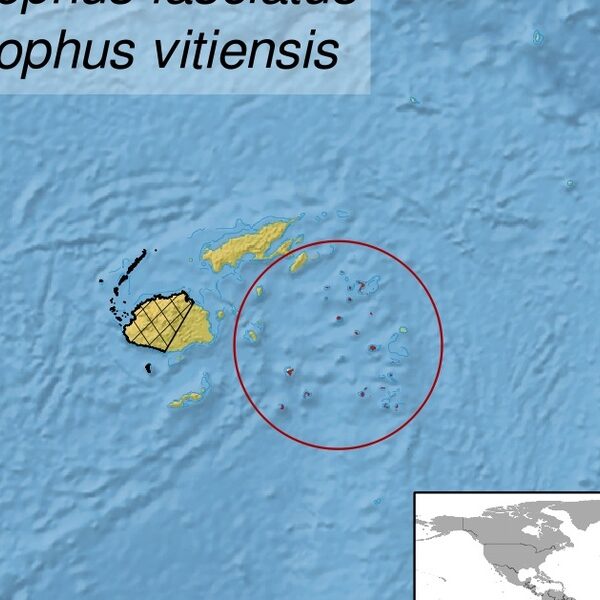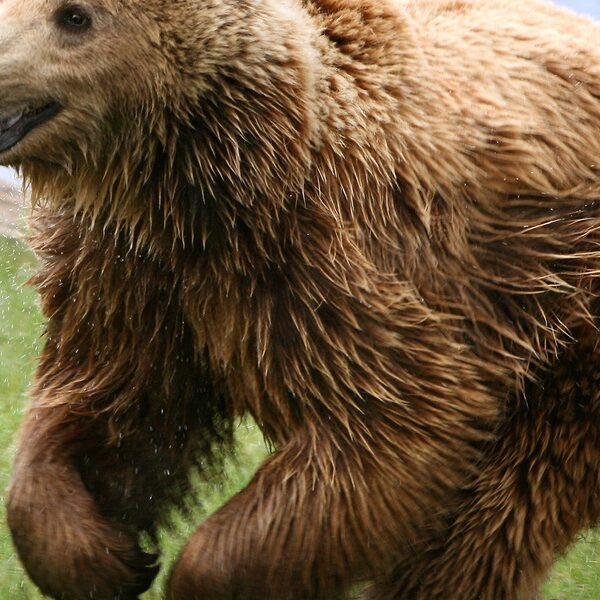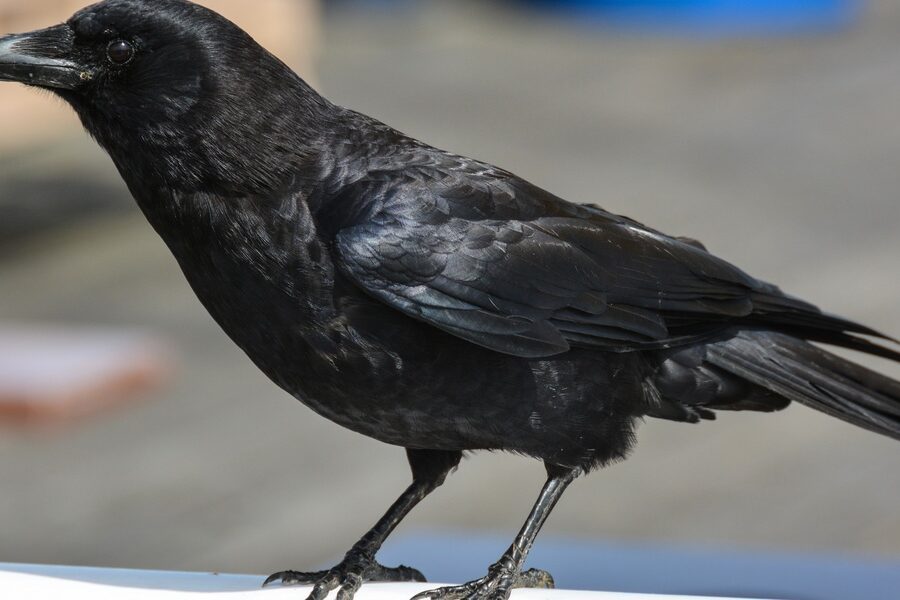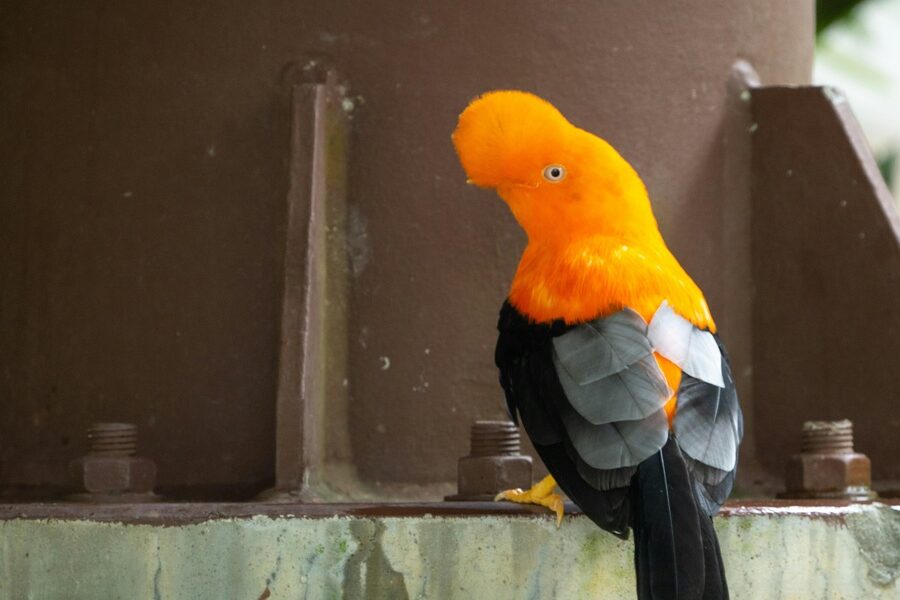The Maldives is best known for its islands and reefs, but its skies and shores support a wide mix of resident and visiting birds that ornithologists and casual observers alike enjoy spotting during island walks and boat trips.
There are 93 Birds of the Maldives, ranging from Amur Falcon to Yellow Wagtail. For each species you’ll find below the Scientific name, Status, and Length (cm) — you’ll find below.
How can I identify common seabirds and shorebirds when I visit the Maldives?
Focus on size, flight pattern, and habitat: terns and noddies are often seen around reefs and resorts, waders on exposed sandbanks, and larger gull-like birds around harbors. Bring binoculars and a compact field guide or app, and compare sightings to the Scientific name, Status, and Length (cm) in the list to confirm ID.
When is the best time to spot migratory species in the Maldives?
Many migrants show up during the drier months after the southwest monsoon, roughly November through April, with peak movements in the cooler season; look along shores, sandbanks and during boat trips, and consult the Status column in the list for notes on rarity and regularity.
Birds of the Maldives
| Common name | Scientific name | Status | Length (cm) |
|---|---|---|---|
| White-breasted Waterhen | Amaurornis phoenicurus | Common resident; breeding. | 28-33 |
| Maldivian House Crow | Corvus splendens maledivicus | Abundant resident; breeding. Endemic subspecies. | 40 |
| Asian Koel | Eudynamys scolopaceus | Common resident; breeding. | 39-46 |
| Indian Pond Heron | Ardeola grayii | Common resident and migrant; breeding. | 42-45 |
| Grey Heron | Ardea cinerea | Common resident and migrant; breeding. | 90-100 |
| Black-crowned Night Heron | Nycticorax nycticorax | Uncommon resident and migrant; breeding. | 58-65 |
| Lesser Frigatebird | Fregata ariel | Common non-breeding resident. | 71-81 |
| Greater Frigatebird | Fregata minor | Uncommon non-breeding visitor. | 85-105 |
| White-tailed Tropicbird | Phaethon lepturus | Uncommon resident; breeding. | 71-82 |
| Brown Booby | Sula leucogaster | Uncommon resident; breeding. | 64-74 |
| Masked Booby | Sula dactylatra | Rare vagrant; potential breeder. | 75-85 |
| Greater Crested Tern | Thalasseus bergii | Common resident; breeding. | 45-49 |
| Lesser Crested Tern | Thalasseus bengalensis | Common non-breeding visitor. | 35-37 |
| Black-naped Tern | Sterna sumatrana | Common resident; breeding. | 30-32 |
| White Tern | Gygis alba | Locally common resident; breeding on Addu Atoll. | 28-33 |
| Bridled Tern | Onychoprion anaethetus | Common migrant and breeding visitor. | 30-32 |
| Sooty Tern | Onychoprion fuscatus | Abundant migrant and potential breeder. | 35-42 |
| Common Noddy | Anous stolidus | Common resident; breeding. | 38-45 |
| Lesser Noddy | Anous tenuirostris | Common resident; breeding. | 30-34 |
| Brown-headed Gull | Chroicocephalus brunnicephalus | Common winter migrant. | 41-45 |
| Whimbrel | Numenius phaeopus | Very common migrant. | 40-46 |
| Eurasian Curlew | Numenius arquata | Uncommon migrant. | 50-60 |
| Bar-tailed Godwit | Limosa lapponica | Common migrant. | 37-41 |
| Ruddy Turnstone | Arenaria interpres | Very common migrant. | 22-24 |
| Sanderling | Calidris alba | Common migrant. | 20-21 |
| Curlew Sandpiper | Calidris ferruginea | Common migrant. | 19-21 |
| Little Stint | Calidris minuta | Common migrant. | 14-15 |
| Terek Sandpiper | Xenus cinereus | Uncommon migrant. | 22-25 |
| Common Sandpiper | Actitis hypoleucos | Very common migrant. | 19-21 |
| Wood Sandpiper | Tringa glareola | Common migrant. | 19-23 |
| Common Greenshank | Tringa nebularia | Common migrant. | 30-35 |
| Common Redshank | Tringa totanus | Common migrant. | 27-29 |
| Grey Plover | Pluvialis squatarola | Common migrant. | 27-31 |
| Pacific Golden Plover | Pluvialis fulva | Common migrant. | 23-26 |
| Lesser Sand Plover | Charadrius mongolus | Very common migrant. | 19-21 |
| Greater Sand Plover | Charadrius leschenaultii | Common migrant. | 22-25 |
| Crab-plover | Dromas ardeola | Uncommon but regular migrant. | 38-41 |
| Pin-tailed Snipe | Gallinago stenura | Common migrant. | 25-27 |
| Black-winged Stilt | Himantopus himantopus | Vagrant, occasionally in small flocks. | 35-40 |
| Barn Swallow | Hirundo rustica | Very common migrant. | 17-19 |
| Indian Roller | Coracias benghalensis | Rare vagrant. | 30-34 |
| Blue-tailed Bee-eater | Merops philippinus | Common migrant. | 28-30 |
| Common Kingfisher | Alcedo atthis | Rare vagrant. | 16-17 |
| Western Reef Heron | Egretta gularis | Uncommon resident; breeding. | 55-65 |
| Cattle Egret | Bubulcus ibis | Common migrant, some residents. | 46-56 |
| Great Egret | Ardea alba | Uncommon migrant. | 85-102 |
| Striated Heron | Butorides striata | Uncommon resident; breeding. | 40-48 |
| Maldivian Little Heron | Butorides sundevalli | Resident; breeding. Often considered a morph/subspecies of Striated Heron. | 40-48 |
| Audubon’s Shearwater | Puffinus lherminieri | Uncommon resident; breeding. | 27-33 |
| Flesh-footed Shearwater | Ardenna carneipes | Uncommon migrant. | 40-45 |
| Wedge-tailed Shearwater | Ardenna pacifica | Uncommon migrant. | 38-46 |
| Swinhoe’s Storm Petrel | Hydrobates monorhis | Rare vagrant. | 18-21 |
| Wilson’s Storm Petrel | Oceanites oceanicus | Rare vagrant. | 16-19 |
| Roseate Tern | Sterna dougallii | Rare vagrant. | 33-38 |
| Common Tern | Sterna hirundo | Common migrant. | 34-37 |
| Saunders’s Tern | Sternula saundersi | Uncommon migrant and possible resident. | 20-23 |
| Little Tern | Sternula albifrons | Uncommon migrant. | 22-24 |
| Gull-billed Tern | Gelochelidon nilotica | Uncommon migrant. | 33-42 |
| Whiskered Tern | Chlidonias hybrida | Uncommon migrant. | 23-26 |
| White-winged Tern | Chlidonias leucopterus | Common migrant. | 20-24 |
| Caspian Tern | Hydroprogne caspia | Uncommon migrant. | 48-56 |
| Heuglin’s Gull | Larus heuglini | Uncommon migrant. | 55-67 |
| Osprey | Pandion haliaetus | Rare vagrant. | 54-58 |
| Shikra | Accipiter badius | Rare vagrant. | 26-30 |
| Amur Falcon | Falco amurensis | Regular migrant in autumn. | 28-30 |
| Common Kestrel | Falco tinnunculus | Rare vagrant. | 32-39 |
| Peregrine Falcon | Falco peregrinus | Rare vagrant. | 38-51 |
| Eurasian Hobby | Falco subbuteo | Rare vagrant. | 29-35 |
| Yellow Wagtail | Motacilla flava | Common migrant. | 15-16 |
| Grey Wagtail | Motacilla cinerea | Common migrant. | 17-20 |
| White Wagtail | Motacilla alba | Uncommon migrant. | 16-19 |
| Richard’s Pipit | Anthus richardi | Rare vagrant. | 17-18 |
| Olive-backed Pipit | Anthus hodgsoni | Uncommon migrant. | 15-16 |
| Rosy Starling | Pastor roseus | Rare vagrant. | 19-22 |
| Common Myna | Acridotheres tristis | Introduced resident; breeding. | 23 |
| Indian Pitta | Pitta brachyura | Rare vagrant. | 18-20 |
| Isabelline Shrike | Lanius isabellinus | Rare vagrant. | 17-18 |
| Brown Shrike | Lanius cristatus | Uncommon migrant. | 18-20 |
| Asian Brown Flycatcher | Muscicapa dauurica | Uncommon migrant. | 12-14 |
| Kashmir Flycatcher | Ficedula subrubra | Rare vagrant. | 13 |
| Bluethroat | Luscinia svecica | Rare vagrant. | 14 |
| Indian Silverbill | Euodice malabarica | Introduced resident; breeding. | 11-12 |
| Greenish Warbler | Phylloscopus trochiloides | Common migrant. | 10-11 |
| Clamorous Reed Warbler | Acrocephalus stentoreus | Rare vagrant. | 18-20 |
| Blyth’s Reed Warbler | Acrocephalus dumetorum | Common migrant. | 12-14 |
| Sykes’s Warbler | Iduna rama | Uncommon migrant. | 11-13 |
| Common Cuckoo | Cuculus canorus | Rare vagrant. | 32-34 |
| Oriental Cuckoo | Cuculus optatus | Rare vagrant. | 30-34 |
| Large-billed Leaf Warbler | Phylloscopus magnirostris | Uncommon migrant. | 12-13 |
| Indian Paradise Flycatcher | Terpsiphone paradisi | Rare vagrant. | 20 (male up to 50) |
| Asian Drongo-Cuckoo | Surniculus lugubris | Rare vagrant. | 25 |
| Chestnut-winged Cuckoo | Clamator coromandus | Rare vagrant. | 47 |
| Pied Cuckoo | Clamator jacobinus | Rare vagrant. | 33 |
Images and Descriptions
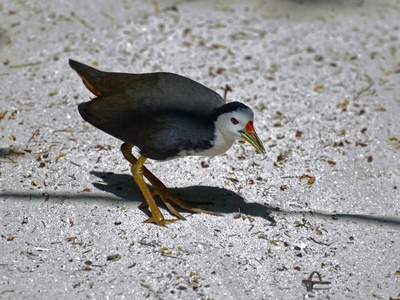
White-breasted Waterhen
A familiar sight on many islands with its dark grey back, clean white face and belly, and reddish-brown patch under its tail. Look for it foraging boldly in resort gardens, wetlands, and scrub, flicking its short tail as it walks.

Maldivian House Crow
An intelligent and opportunistic bird found everywhere, especially near human settlements. Smaller and sleeker than its mainland cousins, this crow is a constant, noisy presence on resort and local islands, adept at finding any unattended food.

Asian Koel
More often heard than seen, the male’s persistent ‘ko-el’ call is a classic island sound. A brood parasite, it lays its eggs in crows’ nests. Males are glossy black, while females are brown with white spots. Found in wooded areas on many islands.

Indian Pond Heron
A small, stocky heron that looks plain brown when at rest but flashes brilliant white wings in flight. Expertly camouflaged, it stands motionless at the edge of freshwater pools or even resort fountains, hunting for fish and frogs.

Grey Heron
A majestic, long-legged wader, the largest heron in the Maldives. Its pale grey body, white neck, and black head plumes make it unmistakable. Often seen standing sentinel on reef flats, breakwaters, or lagoons, patiently waiting for fish.

Black-crowned Night Heron
A stocky, short-necked heron that is most active at dusk and dawn. Adults have a striking black cap and back, grey wings, and white underparts. Look for them roosting quietly in dense trees near water during the day.

Lesser Frigatebird
A pirate of the skies, with long, angular wings and a deeply forked tail. Often seen soaring effortlessly high above the atolls. Males are black with a red throat pouch; females have a white breast. They famously steal food from other seabirds mid-air.
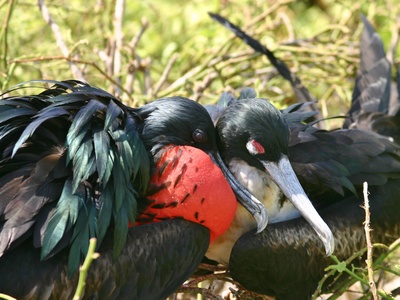
Greater Frigatebird
Even larger than its Lesser cousin, this magnificent seabird is a true master of flight. Look for them soaring over the open ocean or near breeding seabird colonies. Identifying them from the Lesser Frigatebird can be tricky but they are noticeably bigger.

White-tailed Tropicbird
An elegant, pure white seabird with a black eye-mask, yellow bill, and two extremely long, thin white tail streamers. Seeing one is a treat; look for them flying over the open ocean, often near deeper channels between atolls.
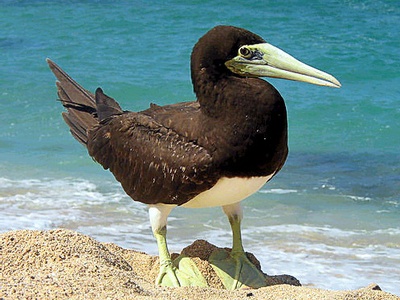
Brown Booby
A compact, powerful seabird with a sharp contrast between its dark brown head and upperparts and its clean white belly. Often seen plunge-diving spectacularly from great heights to catch fish. Nests on a few remote, undisturbed islands.
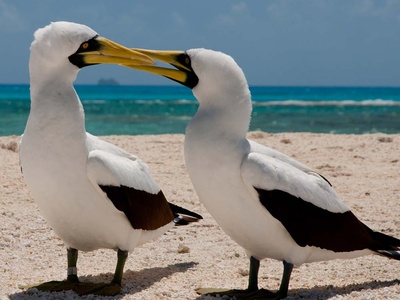
Masked Booby
The largest of the boobies, this striking bird is brilliant white with black flight feathers and a black facial ‘mask’ around its yellow bill. A bird of the open ocean, it’s a rare but memorable sight for those on boat trips in deeper waters.
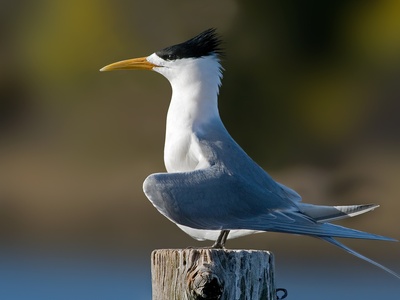
Greater Crested Tern
A large, noisy tern with a shaggy black crest, long yellow bill, and pale grey back. Abundant along coastlines, often in flocks on sandbanks or buoys. Its loud, grating calls are a common sound over the lagoons as it plunge-dives for fish.
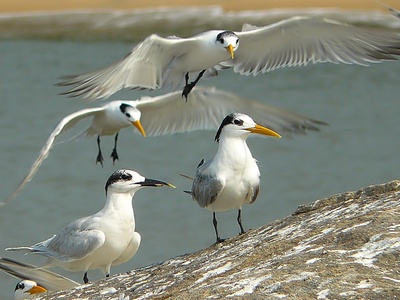
Lesser Crested Tern
Similar to the Greater Crested Tern but smaller and more delicate, with a slender, bright orange bill. Often found mixing in flocks with other terns, resting on sandspits and beaches. A common sight during the migrant season.

Black-naped Tern
A beautiful, small white tern with a fine black line running from its eye to the nape of its neck and a black bill. Nests colonially on sandy beaches and spits. Look for its graceful, buoyant flight over shallow lagoons and reef flats.

White Tern
An ethereal, all-white seabird with large dark eyes and a slightly upturned black bill. Famous for laying its single egg directly on a bare tree branch with no nest. Almost exclusively found in the southernmost atoll, Addu (Seenu).
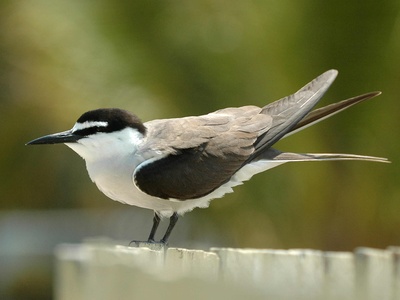
Bridled Tern
A medium-sized tern with a dark grey back, white underparts, and a distinct white ‘eyebrow’ extending past the eye. Nests on offshore islands and is often seen well out at sea, flying low over the waves.
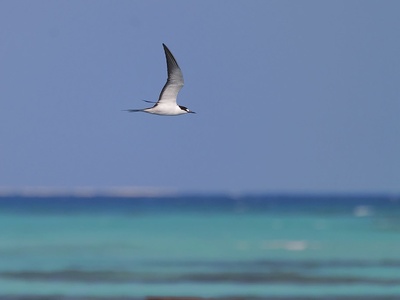
Sooty Tern
A truly oceanic tern with striking black upperparts and white underparts. Often forms huge flocks far out at sea and is rarely seen from land except after storms. Its high-pitched “wide-awake” call is distinctive.

Common Noddy
A dark, sooty-brown seabird with a contrasting pale grey-white cap. Nests in colonies on vegetated islands, often building a simple nest in a bush or tree. Less of a plunge-diver, it prefers to dip and pick food from the water’s surface.

Lesser Noddy
Smaller and darker than the Common Noddy, with a finer bill and a brighter, whiter cap that ends more abruptly. Nests in large, noisy colonies, building substantial nests high in trees, particularly on uninhabited islands.

Brown-headed Gull
In winter, this gull has a mostly white head with a dark smudge behind the eye. It is the most common large gull seen in the Maldives, often found around harbours, fishing boats, and waste disposal islands like Thilafushi near Malé.
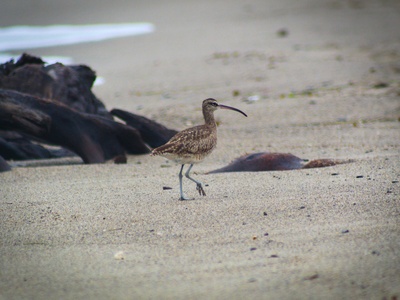
Whimbrel
A large shorebird easily identified by its very long, down-curved bill and striped head pattern. A common sight on reef flats, beaches, and rocky shores across all atolls, probing in the sand and mud for crabs and other invertebrates.

Eurasian Curlew
Even larger than the Whimbrel with an impressively long, decurved bill. It lacks the strong head stripes of the Whimbrel. A more solitary bird, typically seen on expansive reef flats and mudflats, its haunting ‘cour-lee’ call carries far.

Bar-tailed Godwit
A large, elegant wader with a long, slightly upturned bill. In winter plumage, it’s a mottled grey-brown. Famous for its non-stop migration from Alaska to New Zealand, it’s a regular visitor to Maldivian mudflats and reef flats.
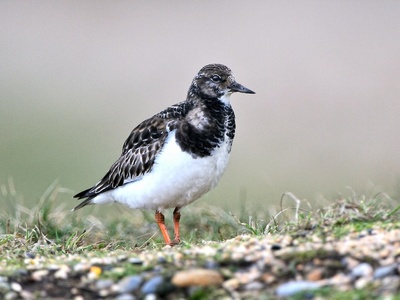
Ruddy Turnstone
A stocky, active shorebird with short orange legs. Its winter plumage is mottled brown and black, but its ‘tortoiseshell’ breeding plumage is spectacular. Found on almost any shoreline, flipping over stones and seaweed to find food.
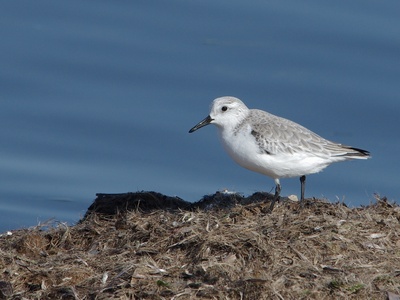
Sanderling
A small, pale sandpiper that looks like a clockwork toy as it runs back and forth with the waves on sandy beaches. In winter, it is very pale grey above and white below, with a black bill and legs. A classic sight on tourist beaches.

Curlew Sandpiper
An elegant, medium-sized sandpiper with a gracefully decurved black bill. In non-breeding plumage, it is plain grey-brown above and white below. Look for it feeding in shallow lagoons and on muddy shores, often in flocks.
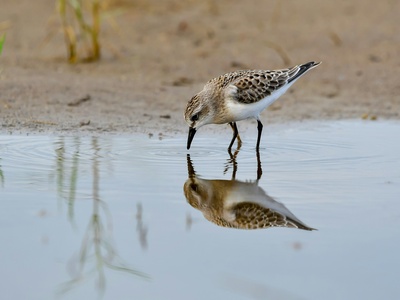
Little Stint
One of the smallest waders, this tiny, energetic bird can be seen in flocks on mudflats and lagoons. Its small size, fine-tipped bill, and fast, busy feeding action are key ID features. Differentiating it from other small stints can be a challenge.

Terek Sandpiper
Instantly recognizable by its long, distinctly upcurved bill and yellowish legs. A very active feeder, often seen running about on mudflats and shallow reef areas. Its unique bill shape makes it stand out from other sandpipers.

Common Sandpiper
A widespread wader found near almost any type of water, from rocky coasts to resort jetties. It constantly bobs its tail and has a distinctive flight style with stiff, flicking wingbeats. Its three-note ‘twee-wee-wee’ call is often heard.
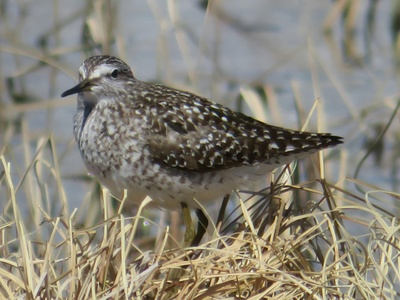
Wood Sandpiper
A graceful, medium-sized wader with yellowish legs and a finely spotted back. It prefers freshwater habitats, so look for it around island wetlands, taro fields, and even flooded sports fields after rain. It has a distinctive sharp, chipping call.
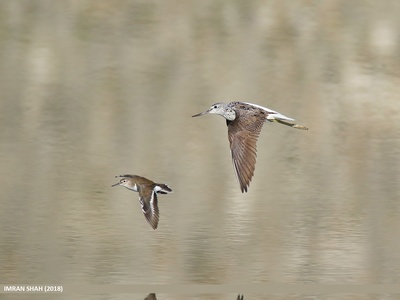
Common Greenshank
A large, elegant wader with long greenish legs and a robust, slightly upturned bill. Often seen singly or in small groups on reef flats and in lagoons. Its loud, ringing ‘teu-teu-teu’ call is a characteristic sound of the shoreline.

Common Redshank
A medium-sized wader identified by its bright red-orange legs, especially visible in flight. It is a nervous bird, quick to fly off with a loud, yelping call. Look for it on mudflats, salt marshes, and shallow coastal waters.
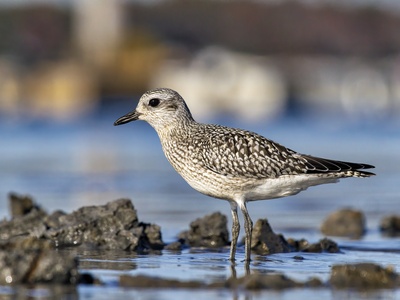
Grey Plover
A stocky, powerful plover with a short, thick bill. In winter, it is a spangled grey and white, but in flight it reveals distinctive black ‘armpits’ (axillaries). Found on sandy beaches, reef flats, and mudflats.
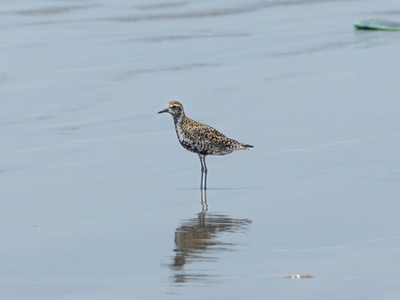
Pacific Golden Plover
Smaller and more slender than the Grey Plover, with a finer bill. In winter, it is a spangled golden-brown, a colour that gives it its name. Often seen on grassy areas like airfields and sports grounds, as well as on coastlines.
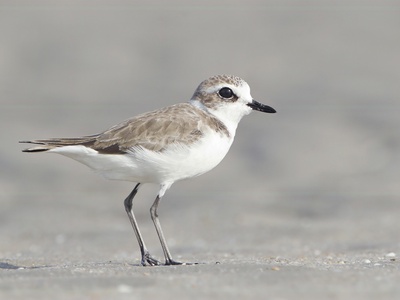
Lesser Sand Plover
A small, compact plover often seen in large flocks on beaches and mudflats. In winter, it has a grey-brown breast band. It’s notoriously difficult to separate from the Greater Sand Plover, requiring close looks at bill size and leg colour.
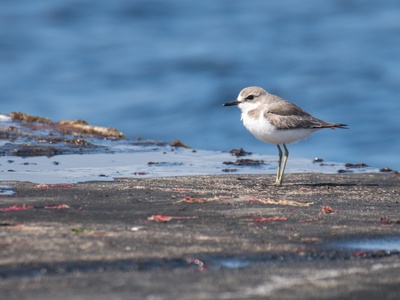
Greater Sand Plover
Slightly larger and longer-billed than the Lesser Sand Plover. This subtle difference is key for identification. It is a common visitor to sandy shores and reef flats, often feeding alongside other waders, probing the sand for invertebrates.

Crab-plover
A unique and striking black-and-white wader with a powerful, gull-like black bill. It is the only member of its family. Look for it on undisturbed coastlines, particularly reef flats where it hunts its primary prey, crabs. A prized sighting for birders.

Pin-tailed Snipe
A secretive and superbly camouflaged wader found in wet, grassy areas, marshes, and taro fields. Very difficult to see on the ground, it is usually only seen when flushed, at which point it rockets into the air with a harsh call.

Black-winged Stilt
An impossibly elegant black and white wader with extraordinarily long, thin pinkish-red legs. Usually seen in freshwater or brackish wetlands. A stunning and unmistakable bird, though a rare visitor to the Maldives.

Barn Swallow
A familiar sight during the migration season, this small bird has glossy blue-black upperparts, a reddish throat, and long tail streamers. Often seen in large numbers, hawking for insects over islands, wetlands, and open water.

Indian Roller
A stunning, stocky bird, about the size of a crow. It appears brownish at rest but reveals brilliant blue and turquoise wings in flight. An unforgettable sight, usually seen perched on a prominent wire or post in open areas.
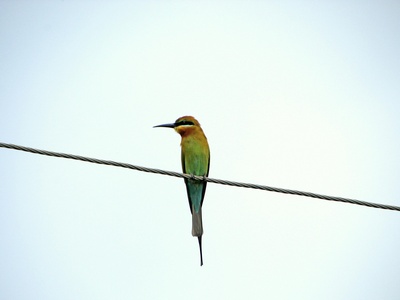
Blue-tailed Bee-eater
A slender, brightly coloured bird, predominantly green with a blue tail and a black stripe through the eye. Often seen in flocks, making acrobatic flights to catch insects. Look for them perched on wires or bare branches on many islands.

Common Kingfisher
A tiny, jewel-like bird with iridescent blue upperparts and a rich orange belly. A flash of blue is often the only view as it darts low over water. A very rare visitor to the Maldives, found near freshwater pools or sheltered lagoons.
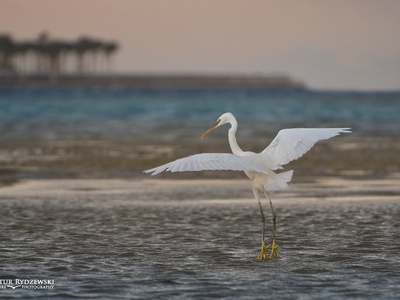
Western Reef Heron
A medium-sized heron that comes in two colour forms: a dark slate-grey morph and a less common pure white one. Inhabits coastal areas, especially rocky shores and reef flats. The dark morph is the one most typically seen in the Maldives.
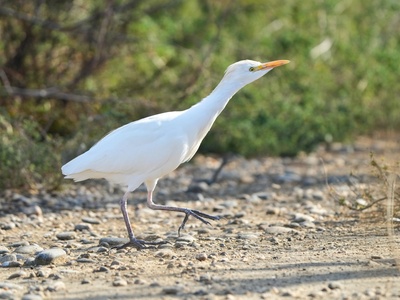
Cattle Egret
A small, stocky white heron. In the breeding season, it develops buff-orange plumes on its head, chest, and back. Often seen foraging in grassy areas, sometimes near airfields, rather than being restricted to wetlands.

Great Egret
A large, elegant, all-white heron with a powerful yellow bill and dark legs. Significantly larger than other white egrets. Typically a solitary hunter, seen stalking prey in shallow lagoons and reef flats.

Striated Heron
A small, secretive heron with a dark cap, greyish body, and short yellow legs. An expert at camouflage, it often crouches low on mangrove roots or jetties, waiting to ambush small fish. Can be found in quiet coastal areas.
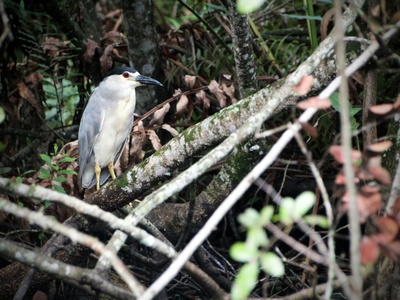
Maldivian Little Heron
This dark, sooty-grey heron is endemic to the Maldives. Often treated as a distinct color morph of the Striated Heron, it is well-adapted to the local environment. Look for it along quiet, rocky shorelines and around island harbours.
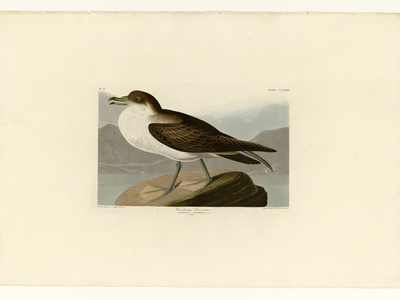
Audubon’s Shearwater
A small, black-and-white seabird of the open ocean. Best seen from inter-atoll ferries or liveaboards. It flies with rapid, stiff wingbeats close to the water surface. Nests in burrows on a few remote, rat-free islands.

Flesh-footed Shearwater
A large, dark sooty-brown shearwater with a pale, pinkish bill tipped with black. A pelagic species, it’s most likely to be seen during sea crossings. It follows a ‘shear-and-glide’ flight pattern typical of its family.
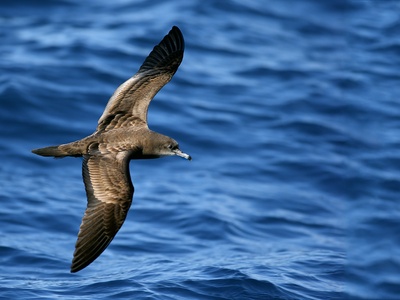
Wedge-tailed Shearwater
A long-winged shearwater that comes in both dark and pale morphs. Named for its distinctive long, wedge-shaped tail, which is a key identification feature. Seen over the open ocean, often in migratory flocks.
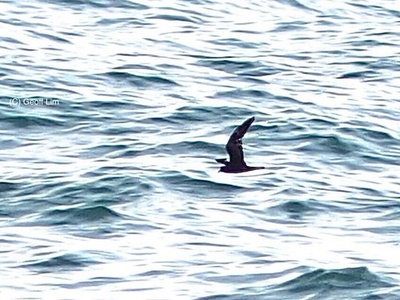
Swinhoe’s Storm Petrel
A small, all-dark seabird that flutters and patters across the sea surface like a butterfly while feeding. A truly oceanic bird, any sighting from land would be exceptional, usually following a major storm. Very hard to identify at sea.
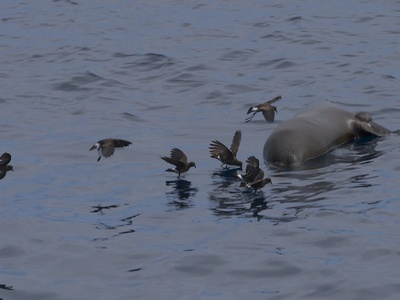
Wilson’s Storm Petrel
Another small, dark storm petrel, but distinguished by a prominent white rump and long legs that trail behind in flight. It has a distinctive flight, pattering its feet on the water’s surface. A bird of the deep ocean.

Roseate Tern
An incredibly graceful, pale tern, similar to the Common Tern but with a longer tail, whiter appearance, and a delicate pinkish flush on its belly in breeding plumage (rarely seen). A very sought-after bird for enthusiasts.

Common Tern
A medium-sized, graceful tern with a grey back, white underparts, and a black cap. In flight, it shows a dark wedge on its outer wing. Widespread during migration, seen over coasts and lagoons throughout the country.
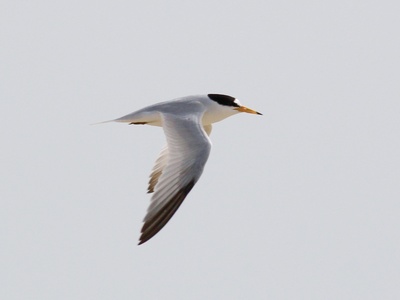
Saunders’s Tern
A very small, fast-flying tern with a yellow bill tipped in black and a white forehead patch. Very similar to the Little Tern, but often has a duskier overall appearance. Found in coastal lagoons and over shallow reefs.

Little Tern
A tiny, delicate tern with a quick, jerky flight. It has a yellow bill with a black tip and a prominent white ‘V’ on its forehead. Hovers expertly before making a sharp plunge-dive for tiny fish in shallow coastal waters.
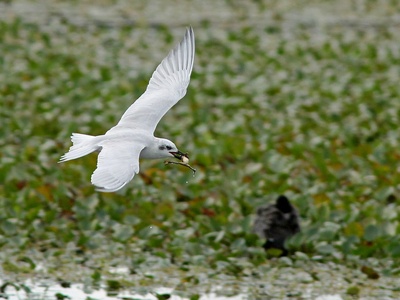
Gull-billed Tern
A stocky, medium-sized tern with a thick, all-black bill that resembles a gull’s, hence its name. It prefers to catch insects in flight or pick food from the ground or water surface, rather than plunge-diving like other terns.

Whiskered Tern
A marsh tern, often seen over freshwater bodies but also coastal lagoons. In breeding plumage it’s striking, with a black cap, dark grey belly, and white ‘whiskers’. More commonly seen in its paler non-breeding plumage.
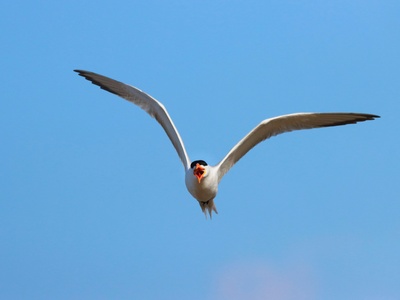
White-winged Tern
The most common marsh tern in the Maldives. Often seen in large, elegant flocks hawking for insects over wetlands or the sea. Breeding plumage is a stunning black with contrasting white wings, a truly spectacular sight.

Caspian Tern
The world’s largest tern, built more like a gull. It’s easily identified by its massive, blood-red, dagger-like bill. A powerful flyer, it can be seen along coasts, patrolling for fish which it catches in spectacular dives.
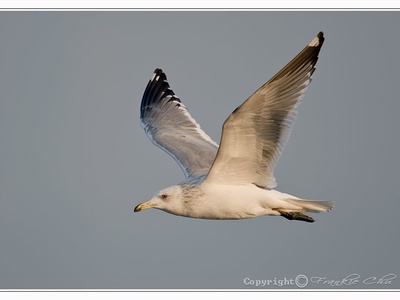
Heuglin’s Gull
A large, dark-backed gull, part of the Lesser Black-backed Gull complex. Identification is very tricky, but it’s a regular winter visitor, especially around Malé and industrial islands, scavenging for food.

Osprey
A large, distinctive bird of prey with a white head, dark eye-stripe, and crooked wings in flight. A specialist fish-eater, it is a rare but spectacular sight, seen hunting over lagoons or perched on a prominent post.

Shikra
A small, fast-flying hawk with typical accipiter features: short, rounded wings and a long tail. A very rare visitor to the Maldives, it would likely be seen hunting small birds in wooded areas of an island.

Amur Falcon
A small, elegant falcon famous for its incredible long-distance migration from Siberia to Southern Africa, crossing the Indian Ocean. Seen in flocks during October/November, often roosting on islands before continuing their journey.
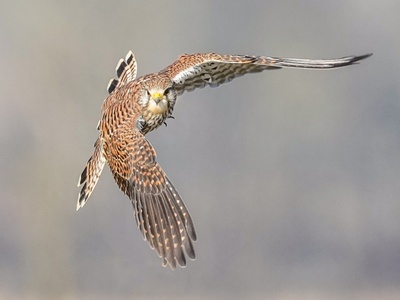
Common Kestrel
A small falcon known for its characteristic hovering flight style while hunting. A rare visitor, it might be seen over open, grassy areas on larger islands, looking for insects or small lizards.

Peregrine Falcon
The fastest animal on the planet, this powerful falcon is a rare but recorded vagrant. Most likely to be seen during migration, hunting other birds with breathtaking speed over coastal areas or atolls.

Eurasian Hobby
A swift, dashing falcon, resembling a small Peregrine. It is incredibly agile, catching large insects and small birds in flight. Any sighting in the Maldives would be a rare migratory record.
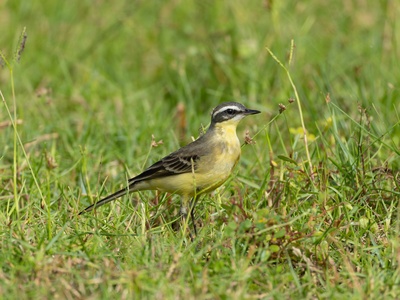
Yellow Wagtail
A slim, elegant bird with a constantly wagging tail. Several subspecies pass through, showing variable head patterns, but all have olive-green backs and yellowish underparts. Found in open, damp, grassy areas and even on manicured resort lawns.

Grey Wagtail
Recognized by its extremely long, wagging tail and bright yellow undertail coverts, which contrast with its grey back. Prefers running water, but in the Maldives adapts to shorelines, jetties, and even puddles in gardens.
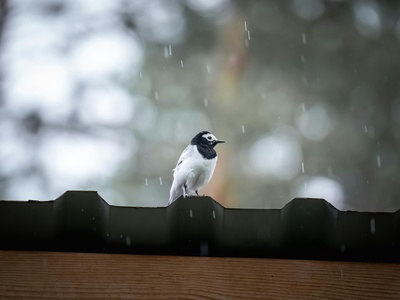
White Wagtail
A smart-looking black, white, and grey bird with a characteristic long, pumping tail. Often seen in open areas near human habitation, such as airport tarmacs, harbours, and open ground, walking briskly as it forages for insects.
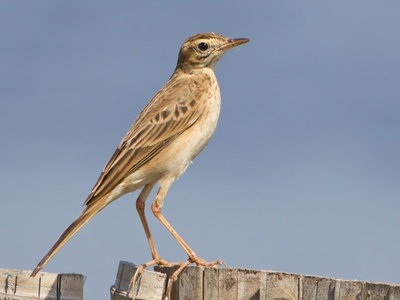
Richard’s Pipit
A large, robust pipit with long legs and a very upright stance. A terrestrial bird of open grasslands and fields. A rare find, it would be seen walking or running on the ground, identified by its size and harsh, sparrow-like call.
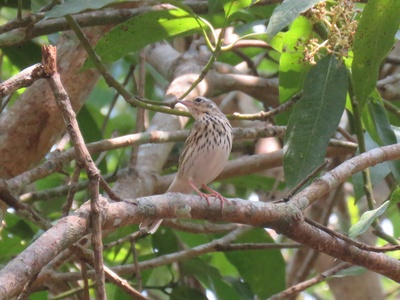
Olive-backed Pipit
A subtly-marked pipit with a greenish-olive back and a distinct, pale eyebrow. Unlike other pipits, it often prefers wooded areas and can be seen walking on the forest floor or perching in trees.
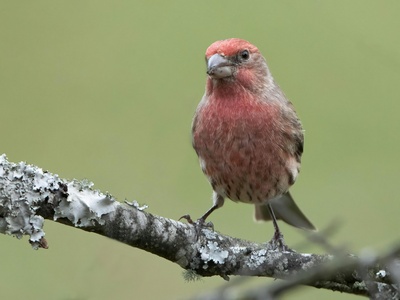
Rosy Starling
An unmistakable starling. In breeding plumage, it has a glossy black head, wings, and tail, with a contrasting pale pink body. A highly irruptive species, it can occasionally appear in the Maldives, sometimes in large flocks.
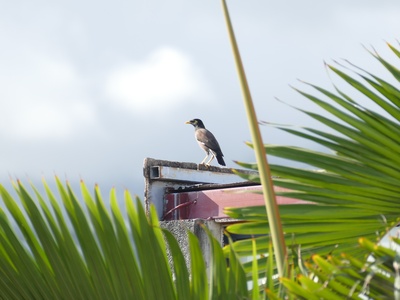
Common Myna
Although introduced, it has established a feral breeding population, particularly around Malé and nearby islands. A noisy, bold bird with a brown body, black head, and distinctive yellow bill, legs, and bare eye-patch.

Indian Pitta
A stunningly colourful but secretive ground-dwelling bird. With its green, blue, buff, black, and white plumage, it’s a jewel of a bird. A very rare migrant, it would be found hopping in dense undergrowth.

Isabelline Shrike
A typical shrike that perches conspicuously on bushes or wires, hunting for insects. It’s a sandy-brown bird with a faint ‘mask’ through the eye. A scarce but regular migrant, found in open scrubby habitats.

Brown Shrike
More common than the Isabelline Shrike, this migrant is also found in open, scrubby areas. It has a warmer brown back and a more prominent black mask through the eye. Known for impaling its prey on thorns, creating a ‘larder’.

Asian Brown Flycatcher
A small, unassuming, and plain grey-brown flycatcher. It has an upright posture and is often seen sallying out from a perch to catch insects in mid-air before returning to the same spot. Found in wooded areas and gardens.

Kashmir Flycatcher
A rare and globally threatened migrant. The male is a beautiful bird with an orange-red throat and breast. A prize for any birder, it would be found flitting through the understory of wooded islands during its migration.
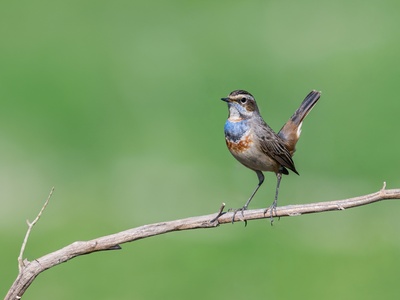
Bluethroat
A small, robin-like bird. The male is named for its stunning blue throat, bordered with black, white and chestnut (though this is often hidden). A ground-hugging bird of dense cover, it’s a very rare winter visitor to marshy areas.

Indian Silverbill
A small, sociable finch with plain sandy-brown plumage and a conical, silvery-grey bill. Introduced to Malé, it has established a small breeding population. Look for flocks in grassy, weedy areas around the capital.

Greenish Warbler
A small, active, and plain olive-green leaf warbler. Best identified by its single pale wing-bar and prominent pale eyebrow. Constantly flits through the foliage of trees and shrubs, gleaning insects. A common winterer in gardens and woods.
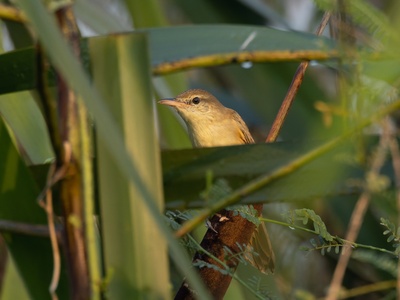
Clamorous Reed Warbler
A large, plain brownish warbler with a powerful voice. A secretive bird that sticks to dense vegetation near water, such as reedbeds or dense scrub around island wetlands. Its loud, churring song would be the best clue to its presence.
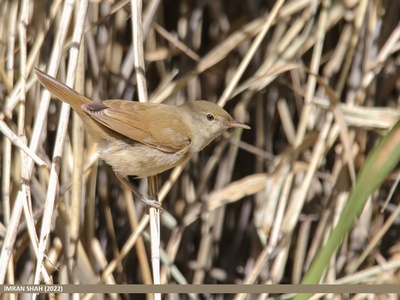
Blyth’s Reed Warbler
A small, nondescript brownish warbler. It is a secretive skulker in dense vegetation but is a very common migrant throughout the islands. More likely to be heard than seen, with a repetitive, chattering song.
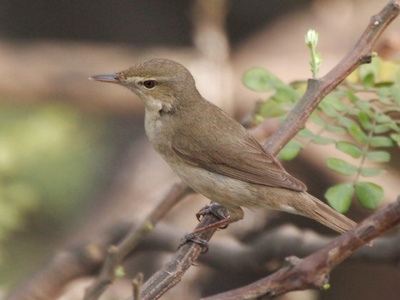
Sykes’s Warbler
A small, pale, sandy-grey warbler found in dry, scrubby habitats. It is an active bird with a habit of flicking its tail. Identification is subtle, relying on structure and bill shape, making it a challenge for birders.
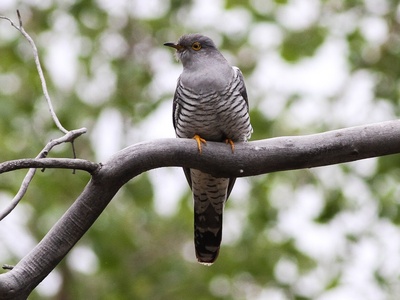
Common Cuckoo
The famous harbinger of spring in Europe is a very rare migrant in the Maldives. A slim, hawk-like bird, usually seen in its grey form. Its iconic ‘cuck-oo’ call is unlikely to be heard here; it would be a silent passage migrant.
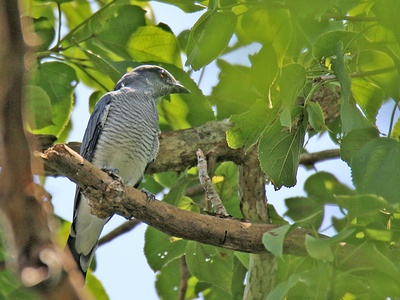
Oriental Cuckoo
Visually very similar to the Common Cuckoo, identification is extremely difficult. It is another rare passage migrant, likely to be found in wooded habitats on any of the islands during its long-distance journey.
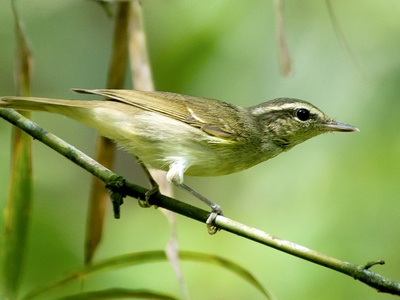
Large-billed Leaf Warbler
Similar to the Greenish Warbler but slightly larger, duller green, and with two pale wing-bars. Its most distinctive feature is its loud, clear, and far-carrying song, a disyllabic ’tiss-yep’. Often found high in the canopy.

Indian Paradise Flycatcher
An absolutely spectacular bird. Adult males have an impossibly long, ribbon-like white tail, a black crested head, and white body. Females and young males are chestnut-coloured. A stunning sight in wooded island habitats.

Asian Drongo-Cuckoo
A glossy black bird that expertly mimics a drongo, likely to reduce aggression from host species. It has a slender, downcurved bill and a notched tail. A brood parasite, it’s a very rare visitor to the Maldives.

Chestnut-winged Cuckoo
A large, striking cuckoo with a pointed crest, bright chestnut wings, and a long, graduated tail. A very rare passage migrant, it would be found in densely vegetated or forested areas of the islands.

Pied Cuckoo
A slim, crested black-and-white cuckoo. Its arrival is often associated with the monsoon on the Indian subcontinent. A rare overshoot to the Maldives, it would be a conspicuous and exciting find for any observer.

